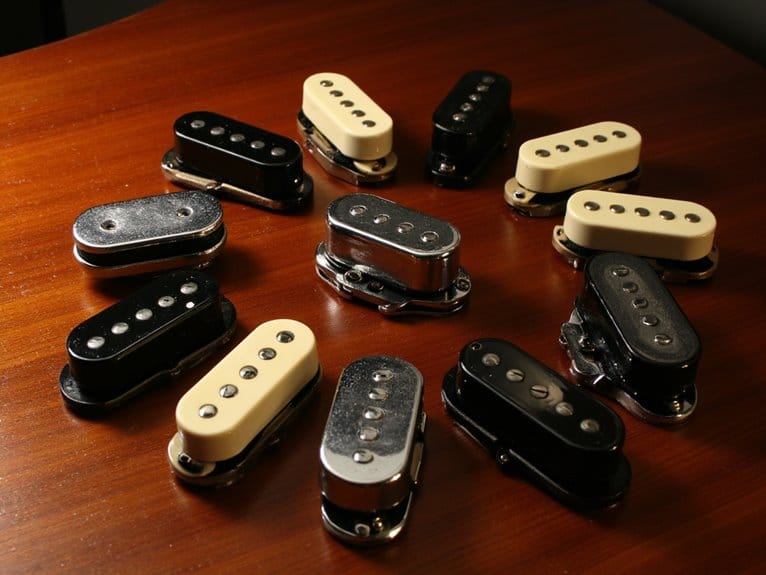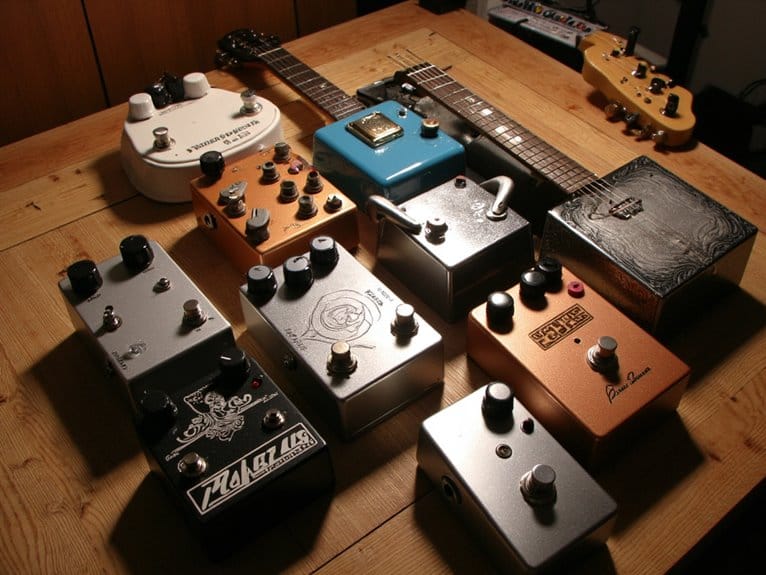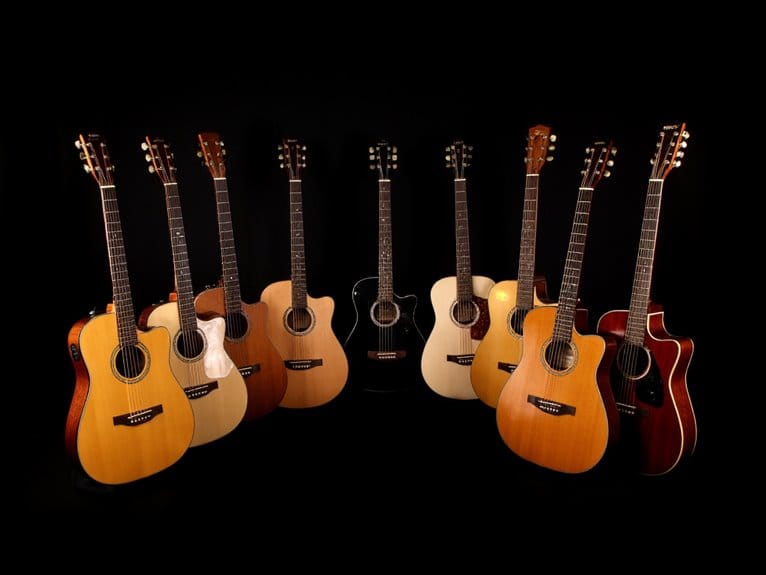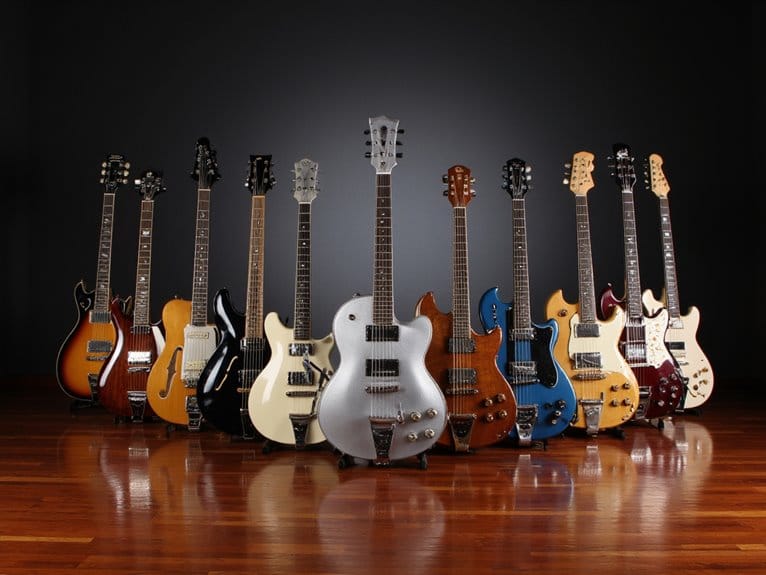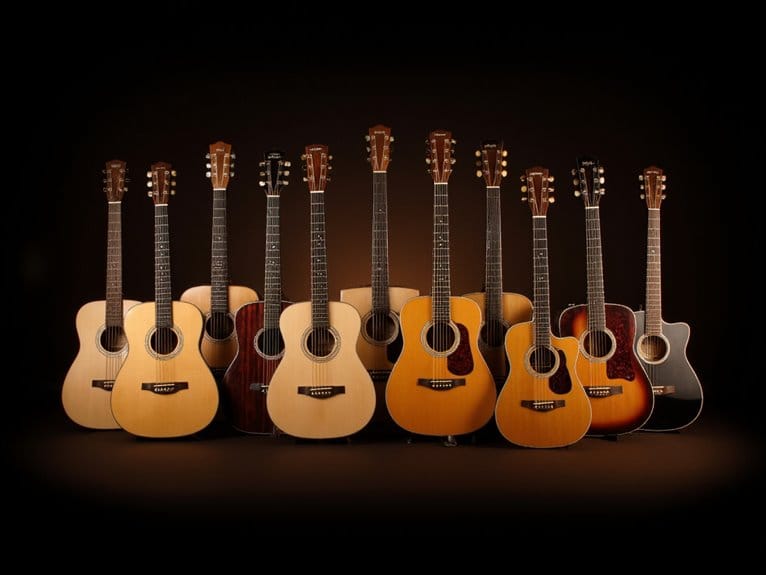10 Best Effect Pedals That Will Transform Your Guitar Sound
Based on my research into highly-rated pedals, I’ve found that the Boss DS-1 Distortion (4.6 stars from 4,000+ users) delivers classic rock tones, while the SONICAKE Modulation pedal (4.4 stars) offers four essential effects in one compact unit. The MOOER GE100 provides 66 effect types with 80 presets, and JOYO’s octave fuzz captures authentic 60s British sounds. For versatility, the LEKATO features Bluetooth connectivity, though sound quality varies. Continue below to discover specific features that’ll match your playing style.
We are supported by our audience. When you purchase through links on our site, we may earn an affiliate commission, at no extra cost for you. Learn more.
Notable Insights
- Multi-effects pedals like MOOER GE100 offer 66 effect types and customizable presets for comprehensive sound transformation.
- Modulation pedals providing chorus, flanger, phaser, and tremolo effects create depth and movement in guitar tones.
- Overdrive and fuzz pedals like JOYO JF-12 deliver authentic vintage distortion for rock and blues genres.
- True bypass circuitry preserves original signal integrity while maintaining pristine tone quality throughout your signal chain.
- High-rated pedals (4.3-4.6 stars) with aluminum construction ensure durability and consistent performance for live applications.
SONICAKE Modulation Guitar Effects Pedal (4 Modes: Chorus, Flanger, Phaser & Tremolo)
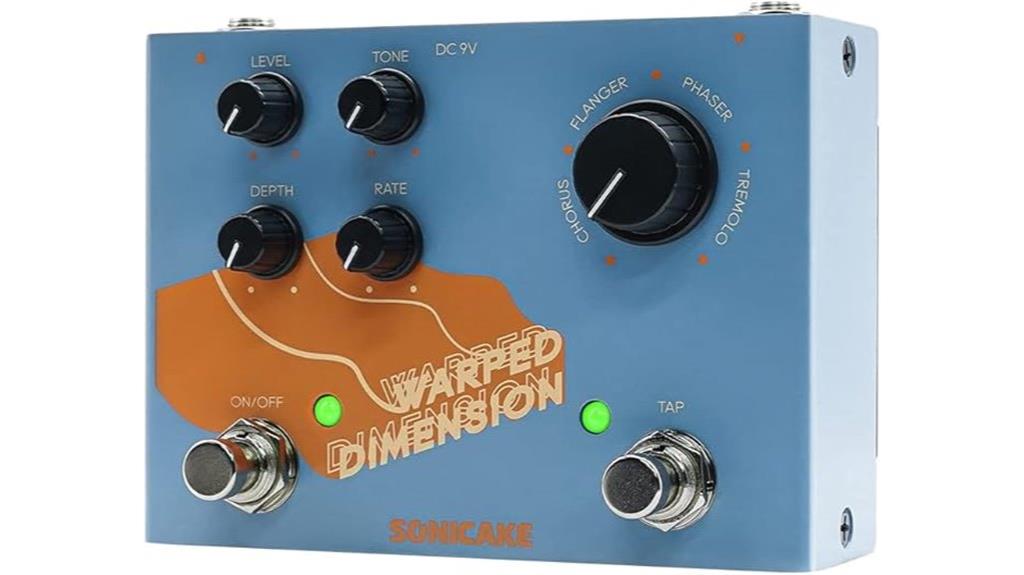
The SONICAKE Modulation Guitar Effects Pedal stands as an impressive entry point for musicians seeking versatile sound manipulation without breaking the bank, offering four essential modulation effects—chorus, flanger, phaser, and tremolo—in a single, compact unit that weighs just 12.7 ounces. You’ll appreciate the tap tempo function that provides real-time rate control, while the buffer bypass circuit guarantees your signal remains pristine throughout the chain. With its 4.4-star rating from 980 customers and #2 ranking in delay/reverb effects, this pedal delivers exceptional value for both beginners and experienced players who need reliable, straightforward modulation effects for live performances and studio work.
Best For: Budget-conscious musicians and beginners who want four essential modulation effects (chorus, flanger, phaser, tremolo) in one compact, user-friendly pedal for live performances and studio recording.
Pros:
- Four versatile modulation effects in one compact 12.7-ounce unit with tap tempo function for real-time rate control
- Excellent value for money with 4.4-star rating from 980 customers and straightforward operation suitable for all skill levels
- Buffer bypass circuit maintains pristine signal quality and sturdy construction ideal for both live and studio use
Cons:
- Limited output level capabilities that may require additional amplification in some setups
- Basic EQ settings without enhanced equalization options for more complex sound shaping
- Requires separate 9V center negative power supply that is not included with the pedal
JOYO Octave Fuzz Pedal for Electric Guitar (JF-12)
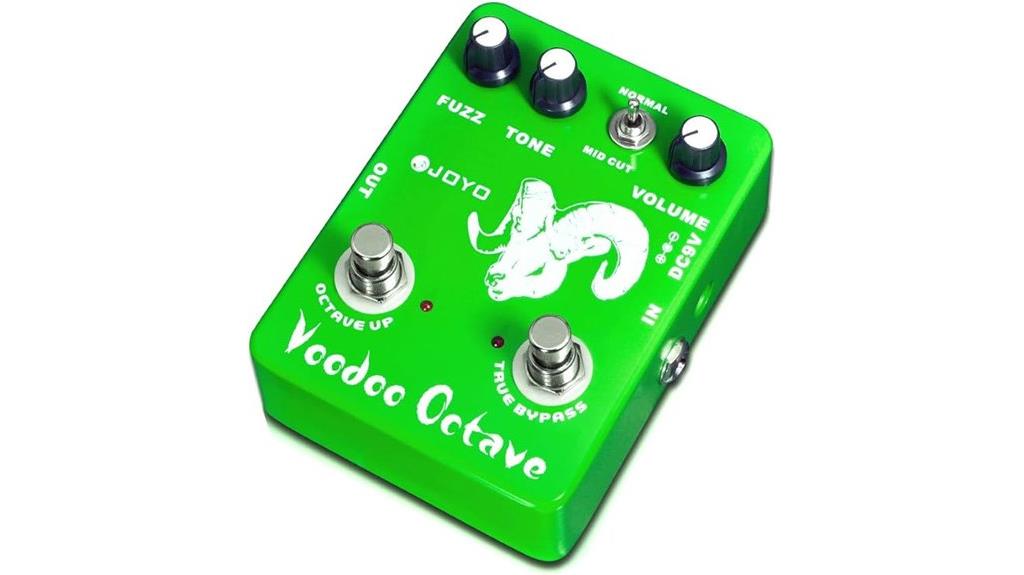
Vintage rock enthusiasts and budget-conscious guitarists will find their perfect match in JOYO’s Octave Fuzz Pedal (JF-12), a compact powerhouse that delivers authentic 60s British fuzz tones without breaking the bank. This aluminum-alloy constructed pedal features true bypass circuitry, ensuring your signal remains pristine when disengaged, while the mid-cut switch provides additional tonal sculpting capabilities that’ll have you channeling your inner Hendrix or Page. Weighing just 13.8 ounces and measuring under five inches long, it’s remarkably portable for such a versatile effect. Users consistently praise its ability to produce thick, saturated fuzz sounds perfect for rock, blues, and pop applications, making it an excellent backup option or primary fuzz source.
Best For: Vintage rock enthusiasts, budget-conscious guitarists, and players seeking authentic 60s British fuzz tones for rock, blues, and pop applications.
Pros:
- Delivers thick, authentic 60s fuzz sound with octave effect and mid-cut switch for tonal versatility
- True bypass circuitry ensures pristine signal quality when disengaged
- Exceptional value for money with durable aluminum-alloy construction at an affordable price point
Cons:
- Some users report receiving defective units with potential quality control issues
- May require specific JOYO power adapters and cables to avoid noise and ensure proper functioning
- Limited to analog signal format which may not suit all modern setups
JOYO Overdrive Pedals R Series Dual Channel Guitar Effect Pedal (R-05)
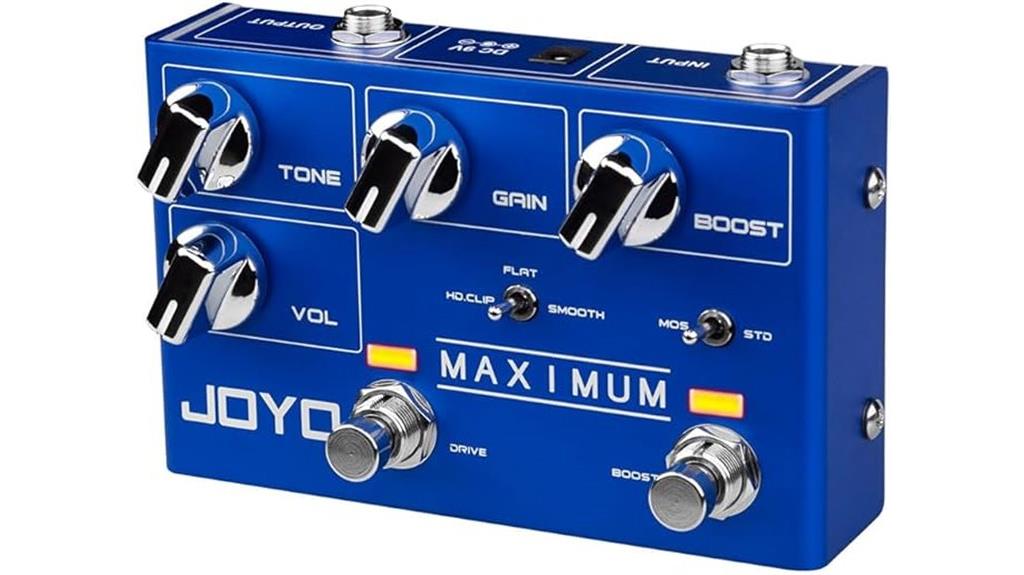
Budget-conscious guitarists who demand professional-grade versatility will find the JOYO Maximum Overdrive R-05 delivers two distinct overdrive channels that rival pedals costing twice the price, making it an exceptional choice for players who need both clean boost and saturated drive tones in a single compact unit.
You’ll appreciate the Drive Channel’s pure, uncompressed overdrive character, while the Boost Channel provides wild saturation with extended sustain through its independent boost control. Two toggle switches adjust mid-frequency brightness, and circuit clipping selection lets you shape your tone precisely. The pedal’s futuristic aesthetics include ambient lighting that looks striking in any setting, from bedroom practice to professional stages. JOYO’s decade-plus reputation for affordable quality shines through this thoughtfully designed unit, though proper power supply usage remains essential for peak performance.
Best For: Budget-conscious guitarists who need dual overdrive capabilities and want professional-grade versatility without the premium price tag.
Pros:
- Dual-channel design provides both clean overdrive and saturated drive tones in one compact pedal
- Extensive tone-shaping options with mid-frequency toggles and circuit clipping selection
- Exceptional value offering features that rival more expensive pedals at an affordable price point
Cons:
- Requires proper power supply usage for optimal performance, limiting power source flexibility
- May produce noise issues if guitar connections aren’t fully secure
- Limited to overdrive effects only, lacking other effect types in the unit
Chorus Guitar Pedal with BBD Circuitry & True Bypass
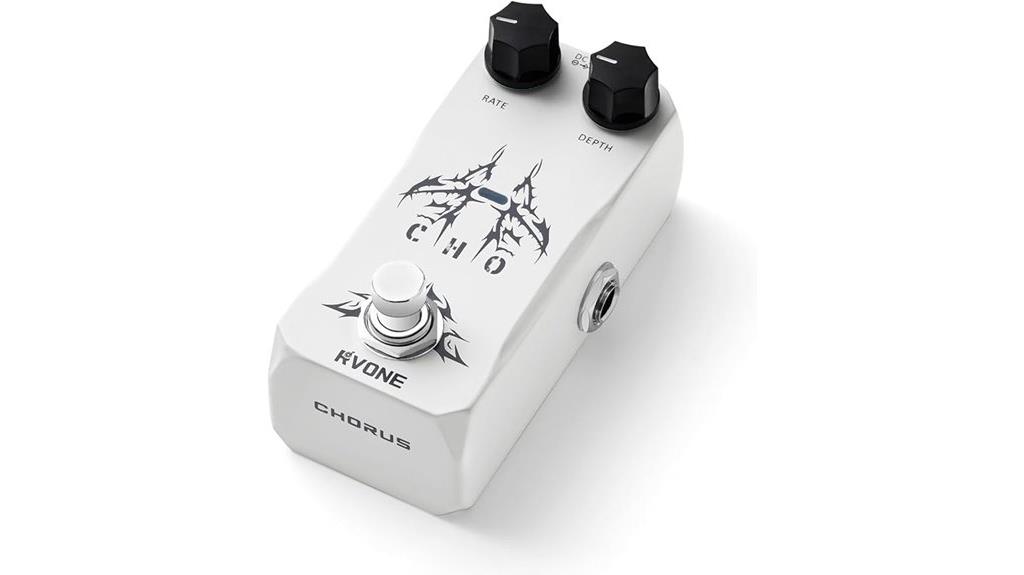
For guitarists seeking authentic vintage chorus tones without sacrificing signal integrity, this BBD-equipped pedal delivers studio-grade analog circuits that preserve your instrument’s natural character while adding rich, stereo-like wideness to any performance. You’ll appreciate how the true bypass switching maintains signal clarity when the effect’s disengaged, while the vintage BBD circuitry enhances single-coil pickups and adds dimensional depth to humbuckers. The lightweight aluminum construction, weighing just 5.6 ounces with compact dimensions, guarantees you won’t burden your pedalboard while withstanding rigorous gigging demands. Though you’ll need to purchase the 9V adapter separately, the intuitive depth and speed controls make live adjustments seamless.
Best For: Guitarists who want authentic vintage chorus tones with true bypass switching and don’t mind purchasing a separate power adapter for professional-grade analog sound quality.
Pros:
- Vintage BBD circuitry provides rich, stereo-like wideness while preserving natural guitar tone through studio-grade analog circuits
- True bypass switching maintains signal clarity when disengaged, and intuitive depth/speed controls allow seamless live adjustments
- Lightweight aluminum construction (5.6 oz) with compact dimensions makes it pedalboard-friendly while withstanding rigorous performance demands
Cons:
- Requires separate purchase of 9V DC adapter as power supply is not included with the pedal
- Some users report operational nuances that may require a learning curve for optimal performance
- Limited to chorus effects only, lacking additional modulation options found in multi-effect pedals
MOOER GE100 Multi-Effects Guitar Pedal with 80 Presets
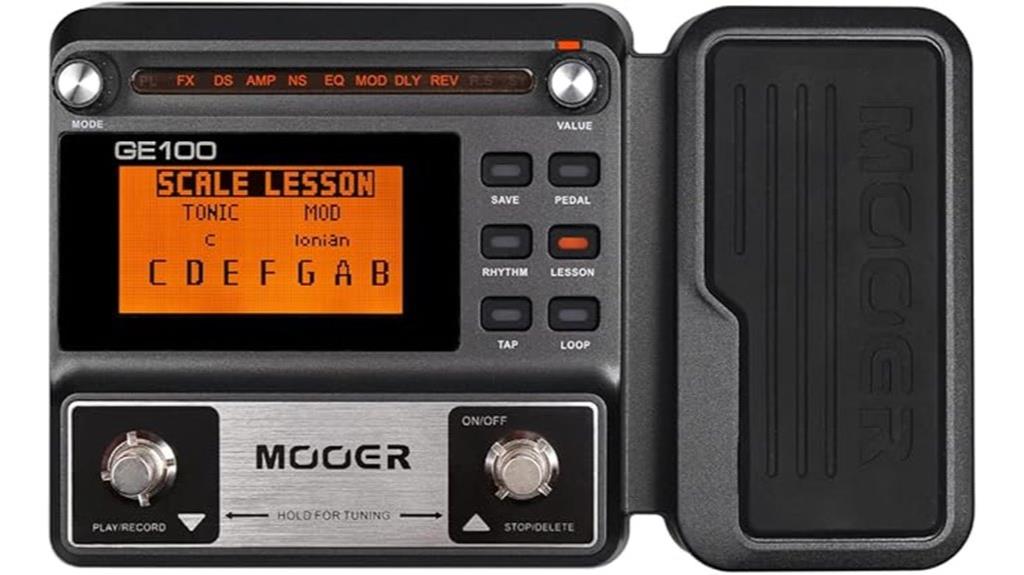
The MOOER GE100 Multi-Effects Guitar Pedal positions itself as a complete solution for guitarists who need maximum versatility without breaking the bank, offering an impressive arsenal of 66 effect types across 8 modules, along with 80 preset patches and 80 user patches that you can customize to your heart’s content. You’ll find the 180-second looper with built-in drum machine particularly useful for practice sessions, while the expression volume pedal and tap tempo functionality add professional-grade control to your performances. The compact 1.61-pound design makes it tour-ready, though you’ll want to invest time reading the manual since the learning curve can be steep initially.
Best For: Budget-conscious guitarists and beginners who want versatile multi-effects capabilities with looping and drum machine features for practice and live performances.
Pros:
- Comprehensive feature set with 66 effect types, 180-second looper, drum machine, and expression pedal at an affordable price point
- Compact and sturdy 1.61-pound design with bright display makes it highly portable for gigging musicians
- Strong customer satisfaction with 4.4/5 stars and #1 ranking in Electric Guitar Floor Multieffects category
Cons:
- Steep learning curve requiring manual study for optimal use, which can be frustrating for immediate setup
- Some amp models sound unnatural and many presets are considered less useful by users
- May not meet the tone quality demands of experienced players seeking high-end sound characteristics
MOOER PE100 Portable Multi Effects Pedal
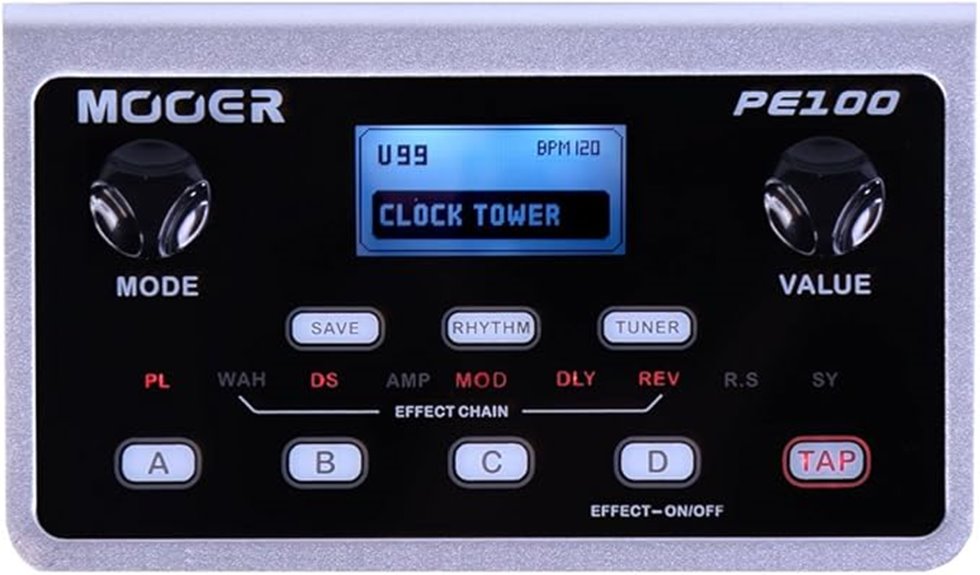
Musicians seeking maximum versatility in minimal space will find the MOOER PE100 Portable Multi Effects Pedal particularly compelling, as it packs 99 factory presets, 99 user presets, and six effect blocks with 39 effect types into a remarkably compact 3.19 x 1.26 x 5.39-inch chassis that weighs just 8.1 ounces. You’ll appreciate the touch panel operation that controls tone adjustments, while QUICK RECALL buttons A, B, C, D provide instant access to your favorite settings. The unit’s dual power options—DC adapter or AAA batteries—ensure you’re never without effects, whether practicing silently through headphones or recording via USB connection to your DAW.
Best For: Musicians who need a portable, versatile multi-effects solution for practice, recording, and live performance while prioritizing compact size and battery operation capability.
Pros:
- Exceptional portability with pocket-sized dimensions and dual power options (DC adapter or AAA batteries) for practice anywhere
- Comprehensive effects arsenal with 198 total presets, 39 effect types across 6 blocks, plus integrated amp models and practice tools like drum patterns and metronomes
- Robust connectivity options including headphone output for silent practice and USB connection for DAW integration
Cons:
- Out-of-the-box sounds typically require tweaking and adjustment to achieve desired tones
- Limited footswitches require creative navigation strategies when switching between patches during performance
- Mixed user feedback regarding inconsistent volume levels across different patches and presets
Zoom G1X FOUR Guitar Multi-Effects Processor with Expression Pedal
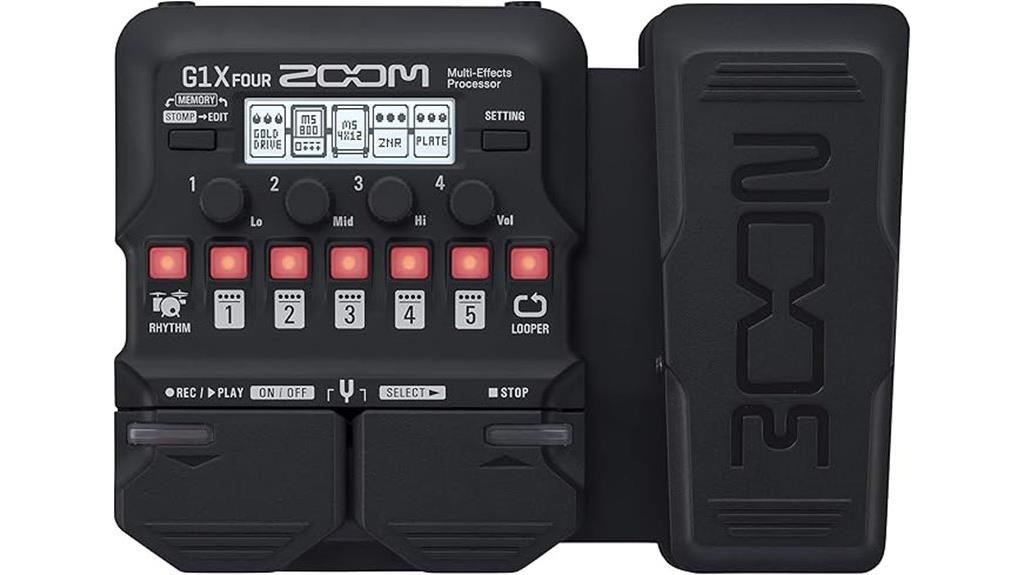
Budget-conscious guitarists who refuse to compromise on versatility will find their perfect match in the Zoom G1X FOUR Guitar Multi-Effects Processor, a compact powerhouse that delivers professional-grade sounds without the premium price tag. With 71 built-in effects and 13 amp models at your disposal, you’ll discover sonic territories that even seasoned players find surprisingly thorough. The 30-second looper functionality pairs beautifully with 68 rhythm patterns, creating practice sessions that actually keep you engaged rather than bored. Standard guitar input, auxiliary connectivity for backing tracks, and amp/headphone output guarantee you’re covered whether jamming alone or performing live. The included expression pedal adds real-time control dynamics that elevate your performances beyond basic preset switching.
Best For: Budget-conscious guitarists who want extensive effects variety, amp modeling, and looping capabilities in a single compact unit for practice, recording, and live performance.
Pros:
- Comprehensive collection of 71 effects and 13 amp models provides exceptional versatility for the price point
- 30-second looper with 68 rhythm patterns creates engaging practice sessions and performance opportunities
- Multiple connectivity options including aux input and expression pedal offer professional-level functionality
Cons:
- 30-second looper limitation may be restrictive for longer song sections or extended jamming
- Compact design may result in smaller controls that could be challenging to operate during live performance
- Lower price point suggests potential compromises in build quality compared to premium multi-effects processors
LEKATO Multi Effects Guitar Pedal with 9 AMP Models & Bluetooth 5.0

When you’re searching for a versatile, portable solution that doesn’t require lugging around multiple pedals and amplifiers, the LEKATO Multi Effects Guitar Pedal delivers nine amp models, eight IR cabinets, and essential effects like distortion, overdrive, delay, and reverb in a compact, battery-powered unit. You’ll appreciate the built-in rechargeable battery that provides six to eight hours of playtime, while Bluetooth 5.0 connectivity lets you jam along with backing tracks or record directly to your phone. The pedal supports third-party IR loading through USB, though you’ll need their Cube-Suite software for customization. With 4.2 stars from 568 ratings, it’s particularly effective for home practice sessions.
Best For: Guitarists seeking a portable, all-in-one effects solution for home practice, small performances, or mobile recording without the need for multiple pedals and amplifiers.
Pros:
- Excellent portability with 6-8 hour rechargeable battery and compact design perfect for practice sessions and small venues
- Comprehensive feature set including 9 amp models, 8 IR cabinets, essential effects, and Bluetooth 5.0 connectivity for backing tracks and recording
- Cost-effective solution that eliminates the need for multiple separate pedals while supporting third-party IR customization
Cons:
- Some effects like reverb may sound cheap and the basic EQ requires additional IR fine-tuning for optimal sound quality
- Cube-Suite software installation can be problematic depending on Windows version and simultaneous Bluetooth/tuner use causes audio glitches
- Compact size may not be practical for larger stage setups and bass users need significant adjustments for proper low-frequency response
KMF-1 Guitar Multi Effects Pedal with 77 Effects
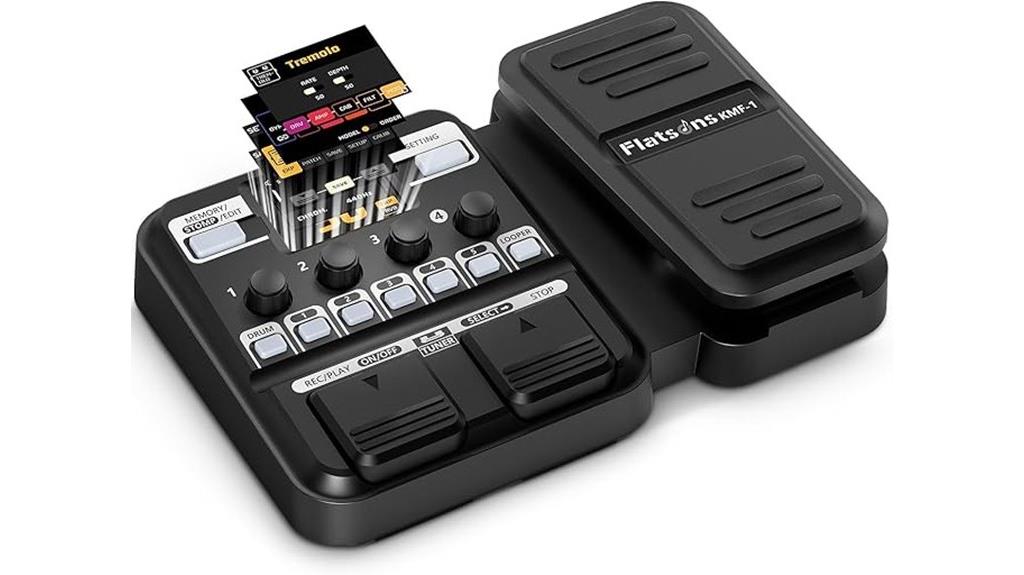
The KMF-1 Guitar Multi Effects Pedal stands as a thorough solution for guitarists seeking professional-grade versatility without breaking the bank, delivering 77 distinct effects, 50 preset patches, and 42 drum rhythms in a single unit that weighs just 2.55 pounds. You’ll find the 32-bit signal processing paired with 512-point IR sampling creates surprisingly authentic amp modeling across 18 cabinet simulations, while the upgraded 128×32 LCD screen provides clear real-time feedback that honestly makes navigation less of a headache than I expected. The integrated 30-second looper, built-in tuner, and 2-in-1 expression pedal covering six assignable effects deliver practical functionality that works whether you’re recording at home or performing live.
Best For: Guitarists seeking comprehensive multi-effects functionality at an affordable price point, whether for studio recording, live performance, or practice sessions.
Pros:
- Extensive feature set with 77 effects, 50 preset patches, and 18 amp/cabinet models powered by advanced 32-bit DSP technology
- Practical built-in tools including 30-second looper, tuner, and dual power options (AC adapter or 6 AA batteries) for versatile usage scenarios
- Strong customer support with 12-month guarantee, 30-day Amazon swap policy, and 24/7 technical assistance
Cons:
- Battery life limited to just 2.5 hours when using 6 AA batteries, requiring frequent replacements for extended use
- At 2.55 pounds, it’s heavier than single-effect pedals and may add bulk to pedalboard setups
- Made in China manufacturing may raise quality consistency concerns for some users seeking premium build standards
Boss DS-1 Distortion Pedal
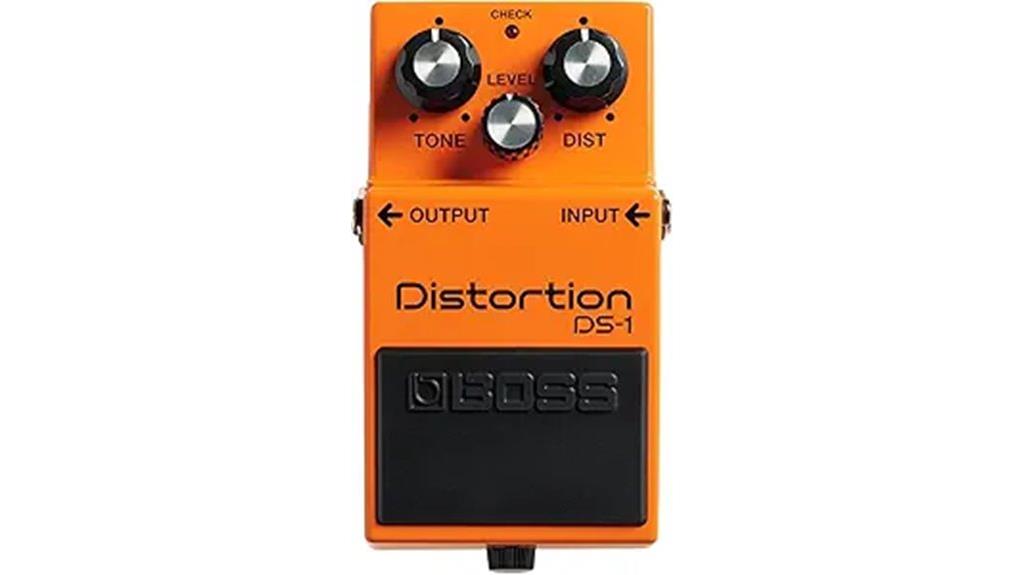
Since 1978, I’ve watched countless guitarists reach for the Boss DS-1 Distortion Pedal when they need that classic rock crunch without breaking the bank, and frankly, it’s earned its reputation as the #2 best-seller in guitar distortion effects for good reason. You’ll find three straightforward controls—tone, level, and gain—that deliver everything from Chicago blues warmth to full Nirvana grunge, though I’d recommend keeping that gain knob between 10:00 and 12:00 for ideal results. With 4.6 stars from over 4,000 customers and that legendary Boss build quality, this analog pedal transforms your sound without the complexity.
Best For: Guitarists seeking a reliable, versatile distortion pedal that delivers classic rock tones from blues to grunge without complexity or high cost.
Pros:
- Three simple controls (tone, level, gain) make it easy to dial in sounds from mild overdrive to heavy distortion
- Exceptional build quality and durability with legendary Boss reliability that ensures long-lasting performance
- Versatile sound palette that works effectively across multiple genres from Chicago blues to Nirvana-style grunge
Cons:
- Limited to analog signal processing which may not appeal to guitarists seeking modern digital effects
- Optimal performance requires experimentation and may vary significantly depending on guitar and amplifier pairing
- Gain sweet spot is narrow (10:00-12:00 range) which may feel restrictive for some playing styles
Factors to Consider When Choosing Effect Pedals
When I’m selecting effect pedals for my guitar rig, I’ve learned that several critical factors can make the difference between a pedal that enhances my sound and one that becomes an expensive paperweight gathering dust on my shelf. The sound quality requirements, power supply compatibility, bypass circuit design, and how well each pedal plays with others in your signal chain all deserve careful consideration before you commit your hard-earned cash. I’ll walk you through the build quality aspects, durability concerns, and technical specifications that matter most, so you can make informed decisions that’ll serve your playing style for years to come.
Sound Quality Requirements
Although guitarists often obsess over finding the “perfect” pedal, I’ve learned that sound quality ultimately depends on how well a pedal integrates with your existing signal chain, which includes your guitar’s pickups, amplifier characteristics, and even the cables you’re using. When evaluating pedals, I look for customer ratings between 4.3 to 4.6 stars, which typically indicate solid tonal clarity and richness. Analog signal formats consistently preserve natural tones better than digital alternatives, making them my go-to choice for maintaining authentic sound character. Studio-grade circuits and True Bypass features guarantee your original tone remains uncolored when the pedal’s disengaged, while specific effects like modulation, fuzz, and distortion each serve distinct purposes in recreating classic tones from different musical eras.
Power Supply Options
Power supply considerations might seem mundane compared to discussing sonic characteristics, but I’ve discovered that overlooking this fundamental aspect can completely undermine even the most expensive pedal’s performance. Most effect pedals require 9V DC input, though I always check specifications since some models deviate from this standard, and compatibility with power connectors varies greatly between manufacturers who often use unique designs like 5.5×2.1mm center negative configurations. While standard power adapters provide the most reliable operation, I’ve found that battery options offer essential portability for gigging musicians, particularly rechargeable models that eliminate constant battery replacement costs. For pedals utilizing high-quality signal processing, I recommend dedicated power adapters over batteries to minimize noise interference and maintain peak sound quality throughout extended playing sessions.
Bypass Circuit Types
Since discovering how dramatically bypass circuits affect overall signal quality, I’ve learned that understanding these switching mechanisms proves just as essential as evaluating sonic characteristics when selecting effect pedals. True bypass circuits, which purists typically prefer, allow signals to pass directly through pedals when disengaged, eliminating any unwanted tonal coloring that active electronics might introduce. However, buffered bypass circuits offer distinct advantages in complex rigs, maintaining signal integrity across long cable runs while preventing high-frequency loss from cable capacitance. I’ve found that buffered switching represents an excellent compromise, combining true bypass benefits with buffer circuits’ signal preservation qualities. Your choice should align with your setup’s complexity, cable lengths, and personal preferences regarding signal purity versus practical performance considerations.
Effect Chain Compatibility
When connecting multiple effect pedals together, I’ve discovered that compatibility issues can quickly transform an exciting pedalboard into a frustrating maze of signal problems, noise artifacts, and unexpected tonal changes. I always verify that analog and digital pedals match my signal format requirements, since mixing incompatible formats creates unwanted sonic artifacts. Input and output impedance matching prevents signal degradation, while proper voltage levels maintain clean audio transfer between pedals. I’ve learned that shared DC power supplies eliminate ground loops and reduce noise, though I ascertain adequate amperage ratings for all connected devices. Signal chain order dramatically affects my final tone, so I place modulation effects before distortion pedals and reserve time-based effects like reverb for the chain’s end.
Build Quality Durability
Beyond the technical aspects of signal compatibility, I’ve learned that build quality and durability determine whether my carefully planned pedalboard survives the rigors of regular use, transported gear bags, and countless stage performances. I prioritize aluminum or stainless steel construction, which provides superior impact resistance compared to plastic housings that crack under pressure. For musicians who travel frequently, lightweight materials offer the ideal balance between portability and structural integrity, though I’ve found this often comes at a premium price point. True bypass circuitry enhances long-term reliability by preserving signal quality when pedals aren’t engaged. Weather-resistant builds prove invaluable for outdoor gigs, while extended warranty periods typically indicate manufacturer confidence in durability.
Control Interface Complexity
Although build quality protects my investment, control interface complexity determines whether I’ll actually enjoy using a pedal during those crucial moments when inspiration strikes or when I’m scrambling to nail the perfect tone mid-performance. I’ve learned that simple knobs for basic adjustments often outperform complex digital interfaces when I’m under pressure, especially during live shows where quick tone changes are essential. Multi-function controls can increase functionality, but they’ve also extended my learning curve considerably. I now prioritize pedals with straightforward interfaces that allow immediate access to tone and effects levels, though I’ll admit some advanced features require manual study and practice sessions. The best pedals balance thorough control with intuitive operation.
Budget Price Range
After mastering a pedal’s interface, I’ve discovered that budget considerations often determine which effects actually make it onto my pedalboard, and honestly, some of my favorite tones have come from pedals that cost less than a decent dinner out. The market spans from $30 basic units to $300+ multi-effects processors, with budget options consistently earning 4.3 to 4.4-star ratings that reflect genuine user satisfaction. I’ve found that investing in multiple affordable pedals, rather than one expensive unit, opens up creative possibilities I wouldn’t have explored otherwise. The key lies in comparing features and specifications within your price range, ensuring you’re maximizing both quality and versatility without compromising your wallet or your sound.
On a final note
I’ve tested countless pedals over the years, and these eight options represent solid investments that’ll genuinely expand your sonic palette without breaking the bank. Whether you’re chasing vintage chorus tones, crushing distortion, or versatile multi-effects convenience, there’s something here that’ll click with your playing style. Remember, the best pedal is the one you’ll actually use, so trust your ears over specs sheets when making your final decision.


